Inside Europe’s €418B Luxury E-Commerce Boom (2025’s Market Size, Forecast & Trends)
Highlights:
- This study reveals the forecasts and trends of Europe’s luxury e-commerce market, as well as its growth projections and outlook for 2025 and beyond.
- In 2023, Europe’s luxury e-commerce market was poised at a value of US$418.5 billion, with a projected CAGR of 7.2% through 2030. UK, France, Germany, and Italy are spearheading this market’s growth.
- Europe now accounts for more than 30% of the global luxury goods market, and many e-commerce agencies are helping businesses of all sizes to carve out an edge in this space. Key segments leading the growth are automotive, beauty and personal care, and consumer electronics, etc.
- Online sales are expected to make up 1/6th of total luxury revenue in Europe in 2027, and m-commerce and social-commerce are prepared to outperform desktop shopping.
- Many challenges remain, for example, Brexit’s effect on cross-border shopping, inflation and rising operational costs. However, top luxury brands, such as LVMH, Gucci, Hermès, adapted quickly, which helped them gain recognition among younger consumers.
- Online sales are projected to make up one-sixth of total luxury revenue in Europe in 2027, and all the major market segments are on track for record-breaking growth by 2029.
In the past, it was believed that the digitalisation of a luxury brand compromised its exclusivity. But during and after the pandemic, many luxury brands faced pitfalls, mainly because they failed to reach the younger generation that now preferred digital platforms over physical stores.
That is when luxury e-commerce in Europe experienced its strongest growth in history.
According to Cognitive Market Research, the European luxury e-commerce, a competitive, cutthroat market, is poised at a value of US$418.5 billion in 2023, with a projected compound annual growth rate of 7.2% through 2030. Europe accounts for more than 30% of the global luxury goods market, and luxury brand owners, CMOs, and directors are well aware that e-commerce is a non-negotiable future for their businesses if they want to stay relevant.
Countries like the UK, France, Germany, and Italy are carving out an edge for e-commerce luxury brands because of consumer demands inclining towards online transactions. Hence, a good place to start with e-commerce is to partner with a luxury e-commerce agency, like Global Bay, or tap into digital strategies to make smart moves in this volatile market.
E-commerce agencies are an invaluable tool in any luxury business’s arsenal. Why? Because they provide cutting-edge UX designs, a superior online and checkout experience, and artificial intelligence features for virtual try-ons. From fashion and lifestyle to home leisure products, luxury brands in Europe are adapting to meet the broader eligibility of the e-commerce market, including discerning shoppers’ desires with a specific emphasis on convenience, exclusivity, and sophistication.
Market Size & Growth Projections of Europe’s Luxury E-Commerce: What Are We Expecting?
Over 2.7 billion people shop online and contribute to $6 trillion worldwide retail e-commerce sales. Europe’s luxury e-commerce market has grown out of this with incredible speed, and it will continue to do well into 2025 and beyond. In 2023, the market was valued at US$418.5 billion (~€389.2 billion or ~£330.8 billion), and with a compound annual growth rate (CAGR) of 7.2% expected from 2023 to 2030, Europe is set to pursue over 30% of the global luxury goods market, which was valued at US$125.55 billion (~€116.76 billion or ~£99.25 billion), according to Cognitive Market Research.

Even Statista has revealed that the e-commerce sales growth in the EMEA luxury goods market grew year-on-year (YoY) by a strong 14% in November 2023.
In the European luxury e-commerce market, key segments spearheading the growth are: automotive, beauty and personal care, consumer electronics, clothing & footwear, home decoration, sports & leisure, travel & tourism and others. The continent is also home to Dior, Gucci, and Chanel, which contributed to the continent’s 2023 valuation of US$111 billion (~€103.2 billion or ~£87.7 billion) for high-end products.
While traditional brick-and-mortar stores are still the hallmark of the luxury shopping experience, e-commerce is expected to become an even larger part of the luxury goods market. By 2027, it is estimated that online sales will account for 1/6th of total luxury revenue in Europe. For luxury fashion and other e-commerce brands, this means that their digital presence must be felt among the affluent consumers while the market is still volatile. Especially in countries like the United Kingdom, France, Germany, and Italy, where global online luxury and jewelry sales are the highest, more and more consumers are turning to e-commerce.
Drivers of Growth and Headwinds
More than half of European luxury e-commerce sales result from desktop shopping (when a customer uses a desktop or laptop to make a purchase).
However, mobile commerce (m-commerce) is making progress at an equally impressive rate and is expected to compete with desktop shopping by 2027.
Mobile luxury shopping is more convenient in comparison to desktop shopping, as consumers can purchase luxury items anytime, anywhere, through brand apps or social media platforms via their smartphone or tablets.
Many modern brands understand these shifts and luxury e-commerce trends, and have optimised their desktop and mobile platforms to meet the high expectations of consumers.
Additionally, according to a new study, Brexit has financially and administratively changed the cross-border luxury shopping in the EU. The introduction of new tax policies and the EU VAT e-commerce package has made transactions of luxury goods between borders more complex for UK-based luxury e-commerce brands. As a result, EU consumers have started preferring EU-based retailers. This makes a significant impact on luxury e-commerce conversion rates as exports from UK to the EU went down by 43%.
Even if British brands experience some friction due to new customs duties, luxury retailers within the UK have adapted quickly, offering distribution centers in EU, faster delivery times, and a better e-commerce UX.
Despite shifting dynamics in the European luxury e-commerce landscape, the market is forecasted to reach US$240 billion (~€223.2 billion or ~£189.7 billion), marking a 7.2% CAGR from 2025 onwards.
For new and emerging e-commerce luxury brands, the key to success is to embrace innovative technologies, cross-border e-commerce efficiency, and leverage the rising expectations of European consumers. Europe’s e-commerce luxury market stands at the cusp of a phenomenal digital transformation, and only those luxury brands that align and position themselves accordingly will capitalise on this market projection and enjoy substantial gains.
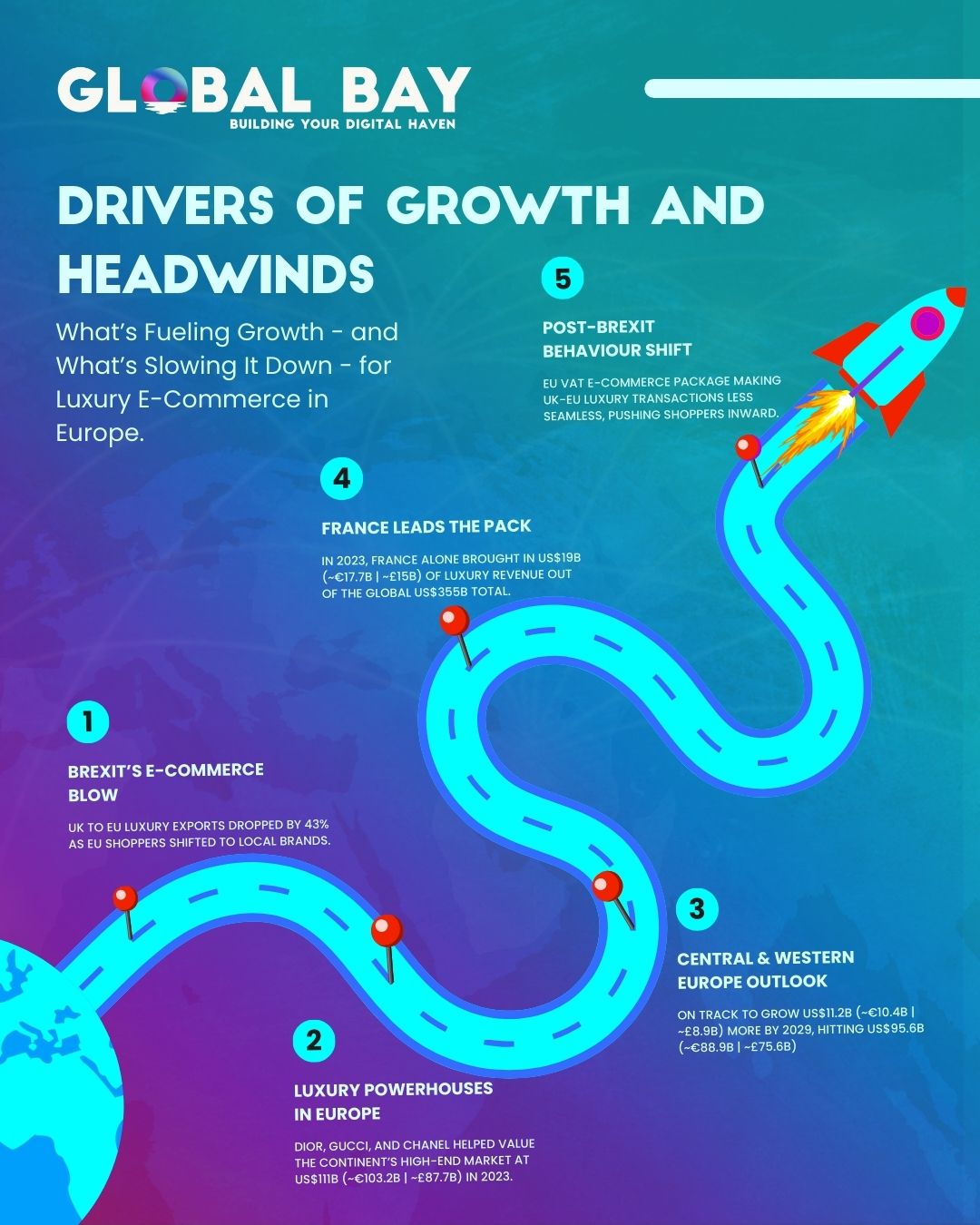
What Role Is A European Luxury Consumer Playing In The E-Commerce Market?
The behaviour and expectations of affluent European shoppers are changing, and luxury e-commerce seems to be balanced on a knife-edge. How luxury goods are consumed is largely defined by mobile luxury shopping, particularly among European women and younger consumers. Those aged 18 to 39 are at the forefront of mobile luxury shopping. This shopping behaviour even surpasses shoppers aged 40 and over. We can also see a generational shift in this consumer behaviour.
As a result, luxury e-commerce brands are redesigning their shopping experiences. Younger consumers are the most frequent users of mobile-friendly platforms to purchase luxury fashion e-commerce products.
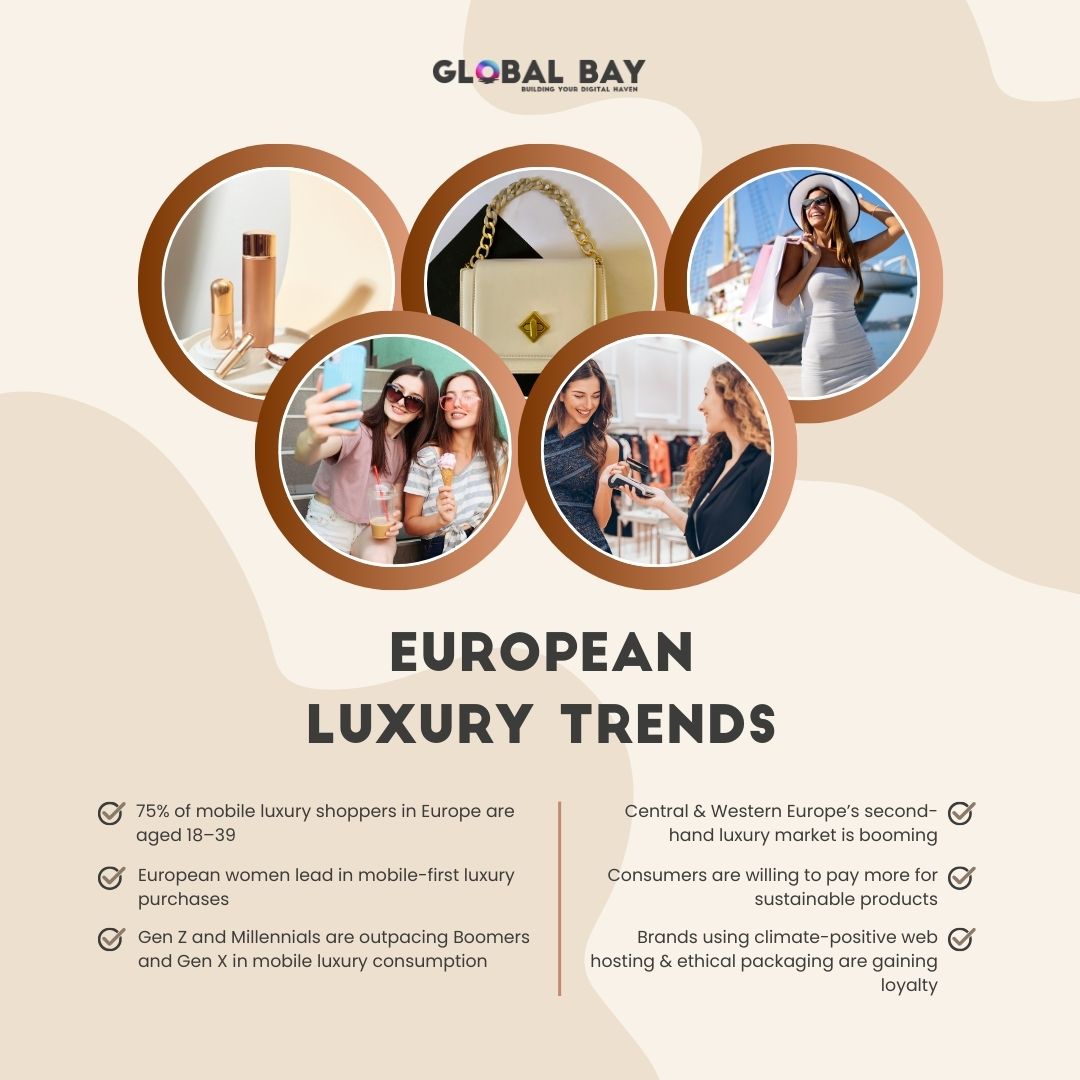
As these consumers are influenced by m-commerce and demand convenience and better shopping experiences, luxury e-commerce conversion rates continue to soar.
Social media has also taken the helm in driving luxury sales in Europe. Platforms like Instagram, TikTok, and Facebook have become key venues of social-commerce, producing direct engagement between consumers and luxury e-commerce brands.
They also influence consumer behaviour.
It is studied that approximately 25% of European consumers ‘liked’ a luxury product on social media in 2023, and nearly 40% of shoppers in countries like France and the UK trusted social media to be an essential information source for luxury fashion.
By the third quarter of 2023, one in six European customers had made a luxury purchase directly through social platforms, thus zeroing in on the importance of social commerce as a key driver in luxury e-commerce sales.
Despite the prevalence of mobile and social media sales, in-store purchases still hold the lion’s share of luxury spend in Europe. According to the luxury goods sales channel that was shared by Statista, the European in-store purchases account for about 86% of total revenue. However, it is only a matter of time before online shopping rivals this. According to a survey conducted in 2024, 63% of luxury consumers in Europe, North America, and Asia purchase luxury goods using a computer.
Sustainability also plays an important role in European luxury e-commerce, with the second-hand luxury goods market seeing monumental growth in Central & Western Europe. Consumers are now interested in sustainable luxury, and some are even willing to pay more for it. This is a prime opportunity for luxury fashion and e-commerce brands to adopt eco-friendly practices. Global Bay is an agency for luxury e-commerce, and working with them gives leverage to such brands, as they offer climate-positive web hosting and other digital green practices.
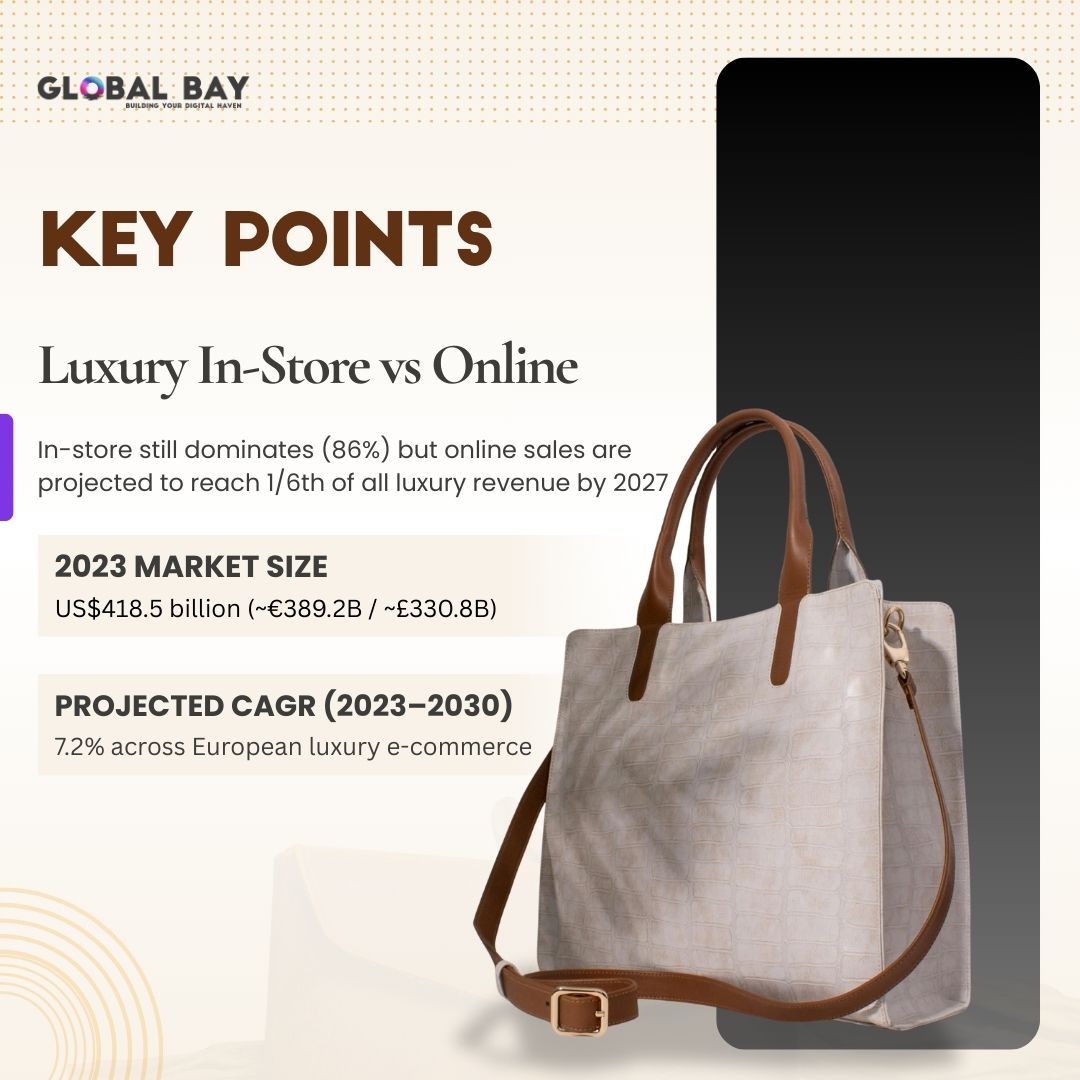
What Is The State of Luxury Goods in Europe by Product?
Europe remains a supreme entity in the luxury goods industry and has introduced many brands that are the epitome of heritage, quality, and exclusivity to the world. In 2023, France led the continent with an estimated US$19 billion (~€17.7 billion or ~£15 billion) in luxury revenue, out of a global industry value of US$355 billion which is heavily driven by luxury fashion.
Regionally, revenue for luxury goods industry in Europe was forecasted to produce US$110.5 billion (~€102.8 billion or ~£87.3 billion) in 2023, and by 2028, it is projected to reach US$133 billion (~€123.7 billion or ~£105.1 billion). Meanwhile, Central & Western Europe is expected to grow by an additional US$11.2 billion (~€10.4 billion or ~£8.9 billion) through 2029, reaching US$95.6 billion (~€88.9 billion or ~£75.6 billion) after the seventh consecutive year.
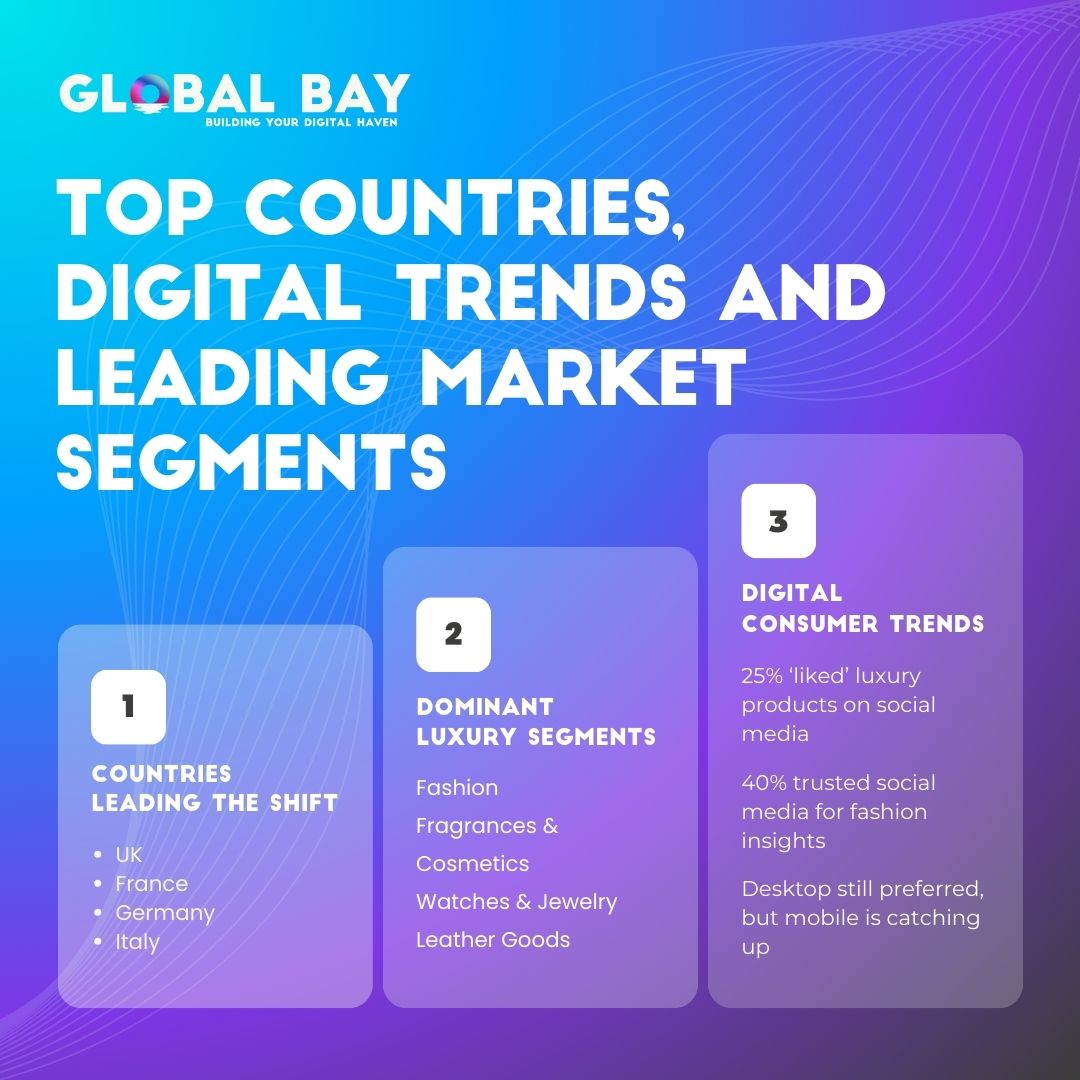
| Segment | 2024 Share / Forecast Highlights |
| Luxury Fashion | The Luxury Fashion market in Central & Western Europe is projected to increase by US$4 billion (~€3.7 billion or ~£3.1 billion) (+12.14%) between 2024 and 2029, and is estimated to reach US$37 billion (~€34.4 billion or ~£29.3 billion) by 2029. |
| Prestige Cosmetics & Fragrances | The Prestige Cosmetics market in Europe is forecasted to grow by €0.5 billion (~US$540 million or ~£420 million) (+8.03%) between 2024 and 2029, reaching €6.75 billion (~US$7.3 billion or ~£5.7 billion) by 2029. The Prestige Fragrances segment will see a larger rise of €1.1 billion (~US$1.19 billion or ~£930 million) (+16.22%) over the same period, reaching €7.87 billion (~US$8.5 billion or ~£6.7 billion) in 2029. Both segments will reach their highest recorded revenues by 2029 after consecutive years of steady growth. |
| Watches & Jewellery | An enduring part of European luxury, watches and jewelry, grew by US$2.7 billion (~€2.5 billion or ~£2.1 billion) (+13.9%) between 2024 and 2029 in Central & Western Europe. Revenue is estimated to reach a new peak of US$22.2 billion (~€20.6 billion or ~£17.6 billion) by 2029, marking the seventh consecutive year of growth. |
| Luxury Eyewear | The Luxury Eyewear market in Central & Western Europe is forecasted to grow by US$590.9 million (~€549.5 million or ~£467.1 million) (+9.76%) between 2024 and 2029. |
| Luxury Leather Goods | Luxury Leather goods follow suit, growing by US$2.2 billion (~€2.05 billion or ~£1.74 billion (+17.32%) between 2024 and 2029 in Central & Western Europe. The revenue is also expected to reach a new peak of US$15.1 billion (~€14 billion or ~£11.9 billion) by 2029, following seven consecutive years of growth. |
There are many agencies for luxury e-commerce in London and parts of Europe that have mastered the art of luxury scarcity marketing in e-commerce. They know how to help luxury e-commerce brands make customers want something they see online. These agencies can boost the luxury e-commerce conversion rates because they know just how to impart luxury to an otherwise robotic online transaction.
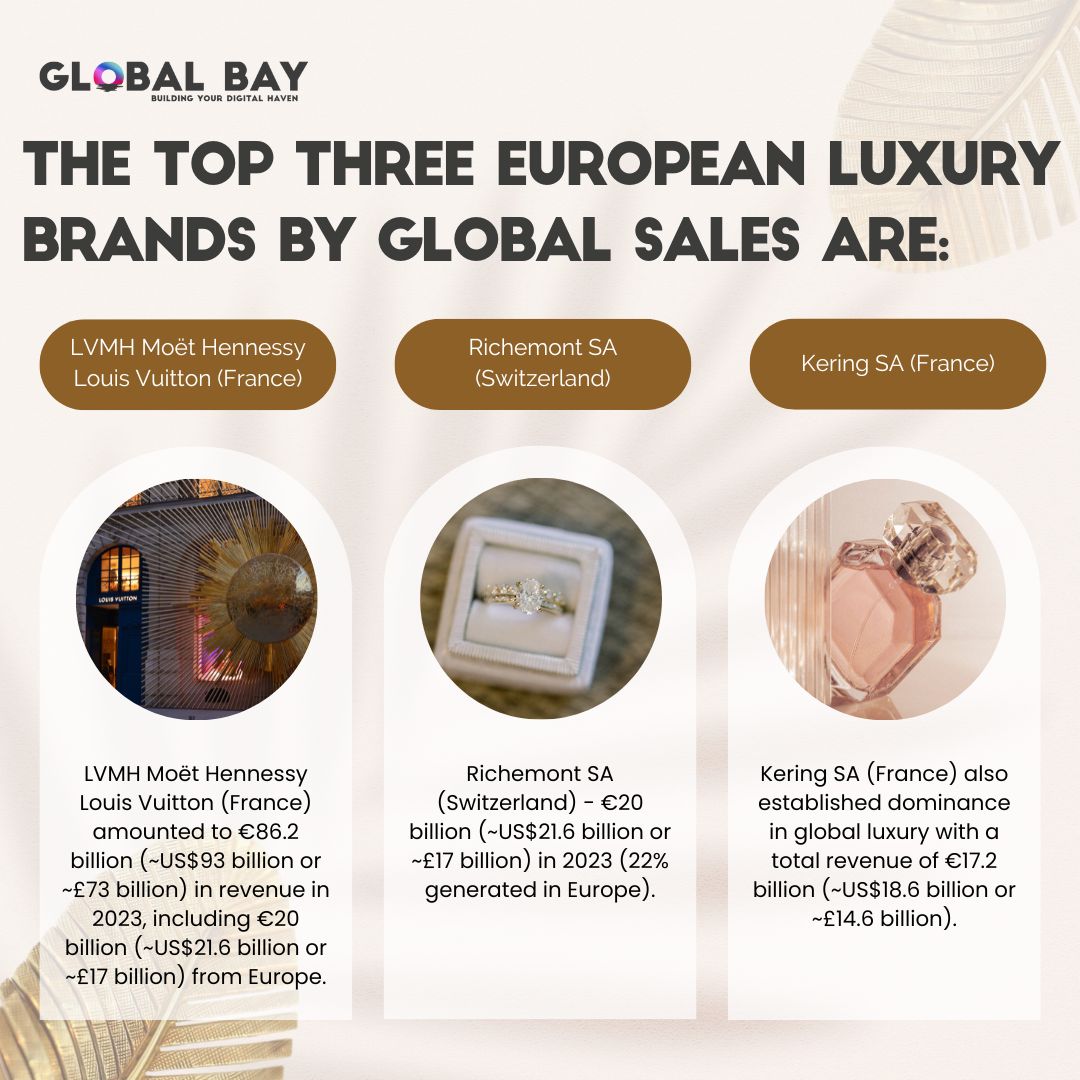
Challenges And Opportunities Unique to European Luxury E-Commerce Brands in 2025
European luxury e-commerce brands entered 2025 with two major challenges: pandemic-era surges and post-COVID realities.
For example, during the pandemic, apparel and footwear e-commerce billing rose from 20% of total sales in 2019 to 32% in 2021. But, ironically, just as the stores reopened, online share dropped below 29% by the end of 2023, leaving many e-commerce luxury brands confused as to why sales declined.
Turns out that the real offenders were the cost-of-living crisis, rising interest rates, and operational cost pressures. These macroeconomic headwinds drove down valuations. Even trailblazing platforms of the past, like Farfetch and Matchesfashion struggled, and other emerging luxury e-commerce brands grappled with their fragile business models that lacked the resilience in the face of slow online growth.
Coming to present times. Europe is home to established luxury fashion brands that have invested heavily in omnichannel strategies encompassing online platforms, physical retail, and VIP services. They pose the most tough competition for new and emerging European luxury e-commerce brands.
Brands like Gucci and Hermès are exploring direct-to-consumer models to enhance their luxury e-commerce conversion rates, which means that third-party platforms have a higher risk of being sidelined, unless they collaborate with these European luxury houses or British luxury goods brands.
A Euromonitor survey in early 2024 showed that over 37% of Europeans now buy pre-owned items every few months. This figure went up 25% since 2019, reflecting a dual imperative for luxury goods industry players. Either they must adapt, or lose their eco-conscious customers.
Despite these challenges, many opportunities are emerging for European luxury e-commerce Brands in 2025:
Focus on Top-Tier Customers
By targeting high-net-worth individuals, luxury e-commerce brands in Europe can generate more than half of their sales with exclusive events or personalised experiences. Luxury e-commerce agencies can help by curating luxurious online journeys, such as with exclusive invites or elite e-commerce packaging.
Expand Into Aspirational Markets
Ultra-high-net-individuals are not the only target audience for e-commerce brands in Europe. Many entry-level luxury consumers, or younger consumers, seek accessible yet prestigious options. Brands must learn how to build “bridge lines” or sub-brands, such as with loyalty programmes and limited-edition and capsule collections, to micro-target this group of customers.
Reinforce Omnichannel and DTC Models
Luxury fashion e-commerce success looks like a blended model of online, mobile, and offline experiences. Consumers want a bit of everything, for example, online booking for in-store appointments, virtual try-ons to purchase luxury goods, etc. A specialised luxury e-commerce agency knows how to raise sales through the roof with UX/UI, AR/VR features, and by optimising conversion touchpoints.
Best Practices for Luxury E‑commerce Brands In Europe in 2025
As luxury brands across Europe face an innovative future of e-commerce, establishing a distinct online presence is a necessity. Those working with Global Bay, an agency for luxury e-commerce, deliver this high-performing experience to their customers by following these best practices in 2025.
1. Showcase Products Visually
In luxury e-commerce, online experiences have big shoes to fill to match the aesthetics and emotional impact of in-store and flagship boutique experiences.

Leading luxury fashion houses, like Hermès and Gucci, are setting examples by offering 360-degree product views, online styling guides, and even AR try-ons. Gucci, for example, allows its customers to try on shoes virtually, while Lancôme offers AR-powered product testing.
Livestreaming is another visual channel that luxury e-commerce brands are adopting in Europe. They create excitement and deepen brand engagement, for example, Burberry’s Tmall fashion show attracted 28 million viewers, something that stunned even the largest luxury brands in the region.
2. Bring Luxury Service Online
For e-commerce luxury brands, offering exclusivity online is a challenging game. But Gucci has set an example for others to come. The “Exclusive Online Services” offer digital showroom tours, one-on-one appointments, consultations, and personalised after-sale care, which pampers customers with the luxury of convenience.
So, for any up-and-coming luxury e-commerce brand, prioritising personalised experiences should be a core strategy. Respect, recognition, and relevance are what invoke human-like emotions in a digital world.
3. Prepare for High Traffic
Product drops and digital launches will bring a traffic spike, and luxury e-commerce brands must be armed with faultless websites and digital platforms. Website crashes have been seen on luxury brand websites before, such as during recent Jacquemus x Nike and Gucci x The North Face drops. Not only did it lead to lost sales, but it also damaged a bit of their reputation. Hence, invest in a good e-commerce luxury agency, which in turn invests in backend performances, seasoned web designers and developers, and traffic control solutions to offer a smooth user experience regardless of demand.
Global Bay is a pioneering force in luxury website creation. By leveraging cutting-edge methodologies to design websites for luxury brands, we have empowered jewellery, premium furnishings and yacht companies and heritage estates, to reach their digital potential. If you ever need assistance with driving sustainable growth, call us through 0117 370 8038. We always respond promptly.
Future Outlook
Europe’s luxury e‑commerce market has more than €17.5 billion (~US$18.9 billion or ~£14.8 billion) online revenue in 2024 and a projected 9 %+ compound growth. The future is not flat; it is inclined upwards. Brands that harmonise heritage with digital experiences, either through AR, AI, sustainability, and premium UX, have rich opportunities lying ahead, because the 2025 onwards landscape of the luxury market is only for agile and future-minded European e-commerce brands.
FAQs & More Forecasts
Question | Insight |
What is the e-commerce forecast for Europe? | The region’s total e‑commerce is projected to reach US$617.73 billion (~€574.5 billion or ~£488.3 billion). |
What is the share of luxury e‑commerce market in Europe? | By 2027, luxury e-commerce is estimated to account for one-sixth of the total revenue in Europe. |
Why is luxury shopping cheaper in Europe? | The European brands like Louis Vuitton, Chanel, and Hermès do not charge overhead costs like transport and duty fees, and also offer VAT (value-added tax) refunds to non-resident visitors to the EU. |
Where is Louis Vuitton cheapest in Europe? | Typically, in France, Louis Vuitton is the cheapest, making it the best place to buy bags and other goods. Italy and the UK also offer lower prices due to VAT refund policies similar to France. |
What are the leading 20 European luxury goods companies? | LVMH comes on top, followed by Kering, Richemont, Christian Dior, Givenchy, Marc Jacobs, and Moët & Chandon among the top luxury retailers. |
Ready to move forward?
Book a consultation call with Global Bay’s director, Jon Basker. Global Bay has services ranging from luxury branding to propositions of brand identities, and can confidently make any luxury brand’s e-commerce strategy a success.
